WMG News
WMG Professor made Fellow of the Royal Academy of Engineering
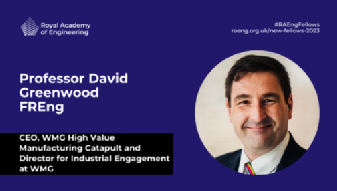 WMG at the University of Warwick’s Professor David Greenwood has been elected a Fellow of the prestigious Royal Academy of Engineering.
WMG at the University of Warwick’s Professor David Greenwood has been elected a Fellow of the prestigious Royal Academy of Engineering.
Professor Greenwood is CEO of the High Value Manufacturing Catapult and Director for Industrial Engagement at WMG.
Professor Greenwood has been elected as part of a group of 73 leading figures in the field of engineering and technology to the fellowship.
The group consists of 60 Fellows, eight International Fellows and five Honorary Fellows, each of whom has made exceptional contributions to their own sector, pioneering new innovations, leading progress in business or academia, providing high level advice to government, or promoting wider understanding of engineering and technology.
The new Fellows will be formally admitted to the Academy at a special ceremony in London on 28 November, when each Fellow will sign the roll book. In joining the Fellowship, they will lend their unique capabilities to achieving the Academy’s overarching strategic goal to harness the power of engineering to create a sustainable society and an inclusive economy for all.
Professor Greenwood commented: "I am truly honoured to be elected as a Fellow of the Royal Academy of Engineering. The UK has tremendous capability in engineering and manufacturing and the work of the Royal Academy is pivotal in helping to achieve its full potential. I look forward to playing my part in that."
Professor Sir Jim McDonald FREng FRSE, President of the Royal Academy of Engineering, said:
“Engineering is everywhere, but nowhere the same, and our new Fellows represent the great breadth and diversity of engineers who are striving to address some of the world’s most complex challenges – benefiting society and the economy in the process. From next generation power networks and water systems to quantum computing and artificial intelligence, our new Fellows are shaping the future.
“We live in an era of rapid change across our communities, our country, and of course our planet. Today we welcome to our Fellowship an inspiring group of people who are harnessing their creativity, courage and commitment to drive positive change in the world around us and we look forward to their contribution to our work.”
View the full list of 2023 fellows here.
WMG charges ahead with battery research
WMG, at the University of Warwick, has received a share of £19 million from the Faraday Institution - the UK’s flagship institute for electrochemical energy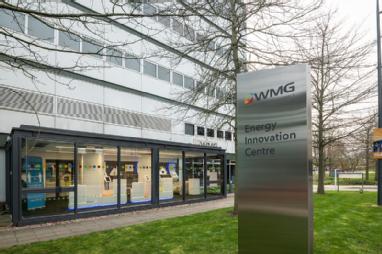 storage research.
storage research.
The funding has been allocated to four key battery research projects aimed at delivering an impact for the UK. These existing projects across three different research areas — next generation cathode materials, electrode manufacturing and sodium-ion batteries — have been reshaped to focus on the areas with the greatest potential for success.
WMG is taking a key role in two of the four, reshaped projects entitled FutureCAT and Nextrode.
WMG’s Professor of Battery Innovation, Louis Piper, will now co-lead FutureCAT, a battery cathode research project, focusing on understanding novel redox processes as a route to stabilise both high capacity, high performance, nickel rich and emerging cathodes and scalable designer morphologies. The project will build on its success in developing reliable, scalable routes to deliver a longer lifetime, high-energy/power cathodes, essential for electric vehicles.
Whereas in Nextrode, a battery electrode project, WMG is one of six university partners, led by the University of Oxford, alongside six industry partners. Researchers at WMG will investigate ways to make electrodes for Li-ion batteries unlocking the electrochemical potential.
Professor Pam Thomas, CEO, Faraday Institution, commented: “The Faraday Institution remains steadfast in its commitment to identify and invest in battery research initiatives that hold the greatest potential for making significant societal, environmental, and commercial contributions. This announcement signals the completion of our latest round of project refocusing, enabling us to allocate even more effort towards those areas of research that offer maximum potential in delivering transformative impact.”
James Gaade, Research Programme Director commented: “We are pleased that the reshaping process has bolstered the capabilities and expertise of researchers on the four projects. The realignment includes a focus around research into sustainable manufacturing methods and materials, and the need to further develop and scale up manufacture of promising materials discovered in the first three years of the projects.”
Project information
FutureCat – High nickel content, high performance cathode materialsLink opens in a new window
FutureCat, co-lead by WMG’s Professor Louis Piper, and the University of Sheffield’s Professor Serena Cussen is targeting step-changes in:
- Understanding novel redox processes as a route to stabilise both high capacity, high performance, nickel rich and emerging cathodes. The project continues its focus on doped and dual-doped lithium nickel oxides (LNO) (both polycrystalline and single crystals), including use of protective coatings. The team will also investigate the use of polyanionic cathodes, use modelling to inform the search for new candidate materials, and research designer electrolytes with the intention of stabilising the interphase layer.
- Scalable designer morphologies. The project will build on its success with doped-LNO in developing reliable, scalable routes to deliver a longer lifetime, high-energy/power cathodes through the use of gradient morphologies, co-doped cathodes (with the aim of delivering reversible discharge capacities exceeding 220 mAh/g), single crystal particles and thin coatings.
- Materials delivery: The scale up of the high nickel W-LNO material previously developed by FutureCat is being transferred to the Degradation project for testing in industry-relevant pouch cells. FutureCat will continue to investigate the manufacturing scale-up of other Ni-rich cathode materials, down-selecting promising active materials based on earth-abundant elements. Research includes the use of laser patterning to increase power densities, investigation of cracking as a failure mechanism to determine routes to resilient cathode manufacture, atomic layer deposition of coatings to improve electrode longevity, and optimisation of cycle life through the use of electrically conductive binders.
Nextrode – electrode manufacturingLink opens in a new window
Nextrode is focused on researching, understanding and quantifying the potential of smart electrode manufacturing to reduce manufacturing costs and improve the performance of batteries. Benefits could be realised in both mature material systems already used commercially and in new emerging high performance battery systems. The project is developing new practical manufacturing innovations – including traditional slurry cast electrodes and novel low or no solvent electrodes – that could deliver the benefits of smart electrodes to the industrial scale and improve sustainability of processes.
The project is researching the underpinning manufacturing science that could alleviate constraints in electrode manufacturing through engineering particle design and improved understanding of the relationship between powder properties and deposition/calendering techniques. Nextrode is designing manufacturing process steps and using advanced in-line measurements to enable slurry casting to be brought under closed-loop control. Researchers are manufacturing new arrangements of anode and cathode materials, identifying conditions where benefits are maximised and developing cells that expand the energy-power-lifetime design space.
The new phase of research projects described will progress over the two years from 1 October 2023 to 30 September 2025.
Find out more about WMG’s Electrochemical Engineering research here: Electrochemical Materials (warwick.ac.uk)
For more information on the Faraday Institution, visit www.faraday.ac.ukLink opens in a new window
WMG’s Professor Khastgir quoted in parliamentary inquiry’s call for action on self-driving vehicles
 Today (Friday 15th September), the House of Commons Transport Select Committee released its cross-party report on self-driving vehicles, calling for urgent legislation to be proposed by the Government to support innovators, regulate this emerging technology sector, and give the public confidence in the safety of connected and autonomous mobility.
Today (Friday 15th September), the House of Commons Transport Select Committee released its cross-party report on self-driving vehicles, calling for urgent legislation to be proposed by the Government to support innovators, regulate this emerging technology sector, and give the public confidence in the safety of connected and autonomous mobility.
Professor Siddartha Khastgir, Head of Verification and Validation at WMG, University of Warwick, who gave evidence to the inquiry and is quoted in the report, said:
"The Transport Select Committee is right to say self-driving vehicles (SDV) are a British success story and that our domestic innovators have energy, creativity, and expertise.
"To secure this progress, we need to ensure consumers can be confident of the safety of SDVs, because, as I told the Committee we can have the safest technology, but if we cannot convince the public, they will never use it.
"So, I’m delighted the Committee is calling for the Government to ‘bring forward and pass comprehensive legislation in the next parliamentary session’ to put in place a robust regulatory framework For SDVs, and I look forward to working with industry, ministers, civil servants and parliament to ensure the public can be confident in the safety of the next generation of transport innovation."
Professor Khastgir provided written and oral evidence to the Transport Committee’s Self-Driving Vehicles Inquiry. His evidence has been referenced (significantly) in this report, including the use of the Operational Design Domain (ODD) to design driving conditions so that SDVs can be tested and operate safely; the importance of ‘informed safety’ that the technology developers need to equip the users about the capabilities and limitations of the self-driving technology so they can use the technology safely.
Read the report here: https://committees.parliament.uk/committee/153/transport-committee/news/197460/legislation-needed-to-continue-great-british-success-story-of-selfdriving-vehicles/Link opens in a new window
Bhattacharyya Award finalists “inspiring and diverse examples” of innovative and impactful partnerships between industry and universities
· Improved footballs for use in the World Cup and new technologies for defence against biological and chemical attack are examples of outcomes from six industry–academia partnerships shortlisted for this year’s annual Bhattacharyya Award
· Winning partnership will be announced at awards ceremony in Birmingham on 24 October 2023
The Royal Academy of Engineering has shortlisted six exceptional industry–academia partnerships from across the UK for this year’s Bhattacharyya Award.
The Bhattacharyya Award 2023 and a cash prize of £25,000 will be presented on 24 October 2023 to the team who best demonstrate how industry and universities can work together.
The Bhattacharyya Award is a tribute to Professor Lord Kumar Bhattacharyya KT CBE FREng FRS, the Regius Professor of Manufacturing at the University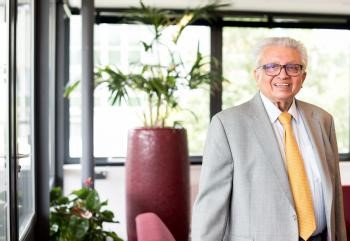 of Warwick and founder of WMG who advocated for greater collaboration between industry and universities. Funded by the Department for Science, Innovation and Technology, the annual Bhattacharyya Award is open to UK universities and colleges that have demonstrated a sustained, strategic industrial partnership that has benefitted society and is deserving of national recognition. Industry–academia partnerships from any academic discipline are eligible for the Bhattacharyya Award.
of Warwick and founder of WMG who advocated for greater collaboration between industry and universities. Funded by the Department for Science, Innovation and Technology, the annual Bhattacharyya Award is open to UK universities and colleges that have demonstrated a sustained, strategic industrial partnership that has benefitted society and is deserving of national recognition. Industry–academia partnerships from any academic discipline are eligible for the Bhattacharyya Award.
This year’s shortlist illustrates the sheer diversity of challenges that can be successfully addressed through collaboration between universities and industry, including national defence against biological and chemical attack, the supply of drinking water, nuclear decommissioning, high-speed global communications, high-performance sportswear and equipment, as well as other challenges like decarbonisation that can be tackled through the power of process systems engineering.
The full shortlist of finalists is as follows:
University of Hertfordshire and the Defence Science and Technology Laboratory (Dstl)
New technologies for defence against biological and chemical threats
The collaboration between the University of Hertfordshire and the Defence Science and Technology Laboratory (Dstl) is focused on next generation devices and systems for monitoring and identifying biological and chemical threats. The collaboration aligns with the University of Hertfordshire’s objectives to stimulate enterprise and innovation, taking a pioneering approach to the transfer of knowledge from academic research to business and government. For Dstl, the collaboration has been central to its mission to explore, sustain, grow and evaluate state-of-the-art technological capabilities to develop protective measures against hazardous biological materials.
Imperial College London, UCL and the Sargent Centre Industrial Consortium
Unleashing the power of process systems engineering research
The Sargent Centre is the world’s largest multidisciplinary research centre in Process Systems Engineering, combining a deep understanding of chemical and biochemical processes with the ability to make fundamental advances across a wide range of systems and digital technologies for the benefit of society and industry. Bringing fundamental research advances to practice is deeply embedded in the Sargent Centre’s approach. For over 30 years, Sargent Centre researchers and process industry partners (e.g., ABB, BP, Eli Lilly and Company, Petronas, Pfizer, Procter and Gamble, Siemens, Shell, Syngenta) have collaborated to address challenges in manufacturing, decarbonisation, energy efficiency, optimisation, data science, multi-scale modelling, risk and uncertainty. This has resulted in successful spin-out creation and software licensing, with tools used across the pharmaceutical, agrochemical, consumer goods, food and energy sectors.
Loughborough University and adidas
Sports equipment and clothes for improved performance, safety and inclusivity
Since 2002, the Loughborough University and adidas cross-disciplinary teams have advanced engineering knowledge that has brought iconic products to market and been translated beyond the global sports sector for wider societal impact, making sport safer, more accessible and allowing people to perform at their best whilst developing the adidas talent pipeline.
The collaborative research has influenced all adidas major tournament footballs since 2004, and the analysis of short duration collisions in football has benefited other sports including new International Standards for cricket helmet performance that have eliminated facial injuries among professional helmeted batters. Another innovation is the first-ever sweat body maps of males, females and children to inform the company’s sector-leading clima® product range. This breakthrough underpins the first virtual Human Thermal Model which enables organisations worldwide to optimise product design for multiple populations across a range of industry sectors.
University of Sheffield and the UK water sector
Keeping drinking water crystal clear
Ageing infrastructure and the complexity of interacting physical, chemical and biological processes occurring within the vast hidden water distribution systems leads to discolouration, an indicator of water quality deterioration, and the number one service contact by consumers. Over the last two decades, by combining world-leading knowledge with a fundamental understanding of the processes and delivery of practical tools and techniques, the University of Sheffield has built the ‘Prediction and management Of Discolouration in Distribution Systems’ (PODDS) consortium across the UK water sector to address these challenges. This innovative partnership has helped the sector achieve improved levels of service without increasing costs, delivering more than 35% reduction in customer contacts regarding water discolouration and increased operational efficiency through better targeting of limited resources.
UCL Optical Networks Group and worldwide telecommunications industry
High-speed ultrawideband and low-delay optical communications networks for the cloud
Optical fibre communication networks underpin global communications, carrying over 95% of all digital data. The work of the Optical Networks Group has been key to the development of this critical high-capacity, low-delay, resilient and secure communications infrastructure. By deeply embedding their industrial collaborators within the group's research, the group has achieved society-wide impact, including a 100,000-fold increase in optical network data capacity, the doubling of transmission distances, and world record data rates, using its one-of-a-kind laboratories and expertise. Since the group was founded in 1994, it has become the centre of a web of over 60 leading international industrial laboratories and companies, across all telecommunications sectors: network operators and content providers (e.g., BT, Deutsche Telecom, Microsoft, KDDI), equipment and device manufacturers (Oclaro (now Lumentum), Nokia Bell Labs, Xtera, ADVA, Mitsubishi, Infinera) and optical fibre manufacturers (Corning, OFS).
University of Manchester and Nuclear Decommissioning sector
Providing expertise for quicker, safer nuclear decommissioning
The UK has been a nuclear nation for 75 years and has accumulated one of the largest. most complex nuclear legacies on Earth. Since 2002, Government has focused on cleaning up this legacy, a programme of work that will last over 100 years and cost over £140 billion. The Dalton Nuclear Institute coordinates the UK’s most comprehensive nuclear academic community, at The University of Manchester, to deliver skilled people, impactful research and support for Government policy development. The Institute’s research has, among other beneficial impacts, led to changes in effluent treatment at Sellafield and reduced discharges to the environment by 50-90%. The team have also developed robots for high hazard settings, including one of Time Magazine’s 200 best innovations for 2022; and improved the management of the UK’s separated plutonium stockpile. In a sector with a critical shortage of experts, the Institute also provides a vital pipeline of talent.
View the videos of the shortlisted partnerships.
Professor Dame Ann Dowling OM DBE FREng FRS, former President of the Royal Academy of Engineering and Chair of the judging panel for the Bhattacharyya Award, said: “The six finalists for this year’s Award are inspiring and diverse examples of successful collaboration between academia and industry—it’s terrific to be able to highlight and to celebrate their innovation and impact and I hope they will provide inspiration for others. We know that there are other great partnerships like these between universities and colleges and industries across the UK in all sectors but that we need many more if we are to fully reap the economic and societal benefit of our research investment and capability.”
The winner of the Bhattacharyya Award will be announced on the evening of 24 October 2023 at a ceremony at the Edgbaston Park Hotel in Birmingham that will showcase the shortlisted partnerships. Anyone wishing to attend should contact awards@raeng.org.uk for more details.
Notes for editors
- WMG, University of Warwick, is a world leading research and education group, transforming organisations and driving innovation through a unique combination of collaborative research and development, and pioneering education programmes. As an international role model for successful partnerships between academia and the private and public sectors, WMG develops advancements nationally and globally, in applied science, technology and engineering, to deliver real impact to economic growth, society and the environment.
- The Royal Academy of Engineering is harnessing the power of engineering to build a sustainable society and an inclusive economy that works for everyone. In collaboration with our Fellows and partners, we’re growing talent and developing skills for the future, driving innovation and building global partnerships, and influencing policy and engaging the public. Together we’re working to tackle the greatest challenges of our age.
Media enquiries to: Pippa Cox at the Royal Academy of Engineering Tel. +44 207 766 0745; email: Pippa.Cox@raeng.org.uk
WMG and Wayve received substantial government funding to research and develop AI safety in self-driving vehicles
- WMG at the University of Warwick and leading self-driving technology developer Wayve have received £1.9 million in government funding to lead a research project on AI safety in self-driving vehicles
- This pioneering project, DriveSafeAI, aims to develop scalable methodologies and mechanisms to prove that the use of AI is safe for self-driving vehicles, which national and international self-driving vehicle developers can adapt the findings to their technology developments
- The project supports the UK government’s ambition to make the UK the leader in AI and its vision of deploying self-driving vehicles in 2025
WMG at the University of Warwick and leading self-driving vehicle technology developer Wayve have been awarded £1.9 million to undertake research to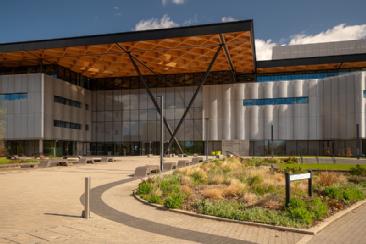 ensure the safe use of AI in self-driving vehicles.
ensure the safe use of AI in self-driving vehicles.
This project, DriveSafeAI, is taking the initiative to research and develop scalable mechanisms and methodologies to prove that AI is safe to use in self-driving vehicles. WMG is a world-class research institution with internationally recognised research capabilities in safety assurance of self-driving technologies, combined with Wavye’s expertise in developing end-to-end machine learning for self-driving, a set of evidence- and data-based methods and tools will be developed and made available for global self-driving developers to test their technologies. The research result will help shape the UK's policy and regulatory framework for AI in the future.
Self-driving vehicles can potentially bring £42 billion in economic benefits to the UK. Proving the safety of AI is a crucial step to unlocking this huge market. However, currently, there is no internationally or nationally agreed methodology in place to prove AI is safe to use in self-driving technologies, which hinders the commercialisation of self-driving vehicles. Therefore, this project will create a solution for AI safety assurance and develop societal trust in AI and self-driving technology.
More information about the DriveSafeAI project and the funding
DriveSafeAI is part of CCAV’s Commercialising CAM Supply Chain Competition (CCAMSC).
The Commercialising CAM programme is funded by the Centre for Connected and Automated Vehicles, a joint unit between the Department for Business and Trade (DBT) and the Department for Transport (DfT) and delivered in partnership with Innovate UK and Zenzic.
The £18.5m CCAMSC competition was launched in October 2022 to support the deployment of self-driving vehicles, by strengthening the capabilities of the sovereign UK CAM supply chain and is part of the Government’s vision for self-driving vehicles. Connected and automated mobility 2025: realising the benefits of self-driving vehicles.
Alex Kendall, CEO and Co-founder of Wayve, said: "At Wayve we know that confidence in our technology is crucial to commercialisation and widespread adoption of self-driving vehicles. Leveraging AI, we have the chance to bring the benefits of self-driving vehicles to everyone’s door. But first, securing trust in AI is paramount.
"That’s why we’ve been working closely with government and academia to ensure the methodologies we use to evidence safety are clear and trustworthy. Today, we’re excited to announce a formal partnership with WMG, University of Warwick, global leaders in the safety of artificial intelligence and autonomous systems. DriveSafeAI will give the public and policymakers confidence in this technology, which has the potential to revolutionise transport."
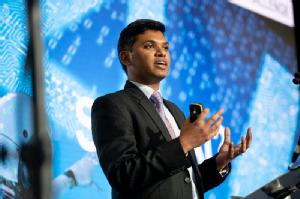 Professor Siddartha Khastgir, Head of Verification & Validation at WMG, University of Warwick, said: "AI – and particularly embodied AI – like self-driving vehicles, is one of the biggest topics currently discussed in society. Deploying this technology safely is essential to realising the huge opportunity AI can offer society.”
Professor Siddartha Khastgir, Head of Verification & Validation at WMG, University of Warwick, said: "AI – and particularly embodied AI – like self-driving vehicles, is one of the biggest topics currently discussed in society. Deploying this technology safely is essential to realising the huge opportunity AI can offer society.”
“At WMG, through DriveSafeAI we are excited to be partnering with Wayve, a leader in self-driving vehicle technology, to help shape the safe AI landscape in the UK and globally.”
“We believe the safety of this technology needs to be proven collaboratively, in a scalable manner and that future policy should have strong research foundations."
Note to editors
About Wayve
Wayve is on a mission to reimagine autonomous mobility through embodied intelligence. Founded in 2017, Wayve is made up of a global team of experts in machine learning and robotics from top organisations around the world. We were the first to deploy autonomous vehicles on public roads with end-to-end deep learning, pioneering the AI software, lean hardware, and fleet learning platform for AV2.0: a next-generation autonomous driving system that can quickly and safely adapt to new driving domains anywhere in the world.
Wayve has raised over $258M and is backed by Eclipse Ventures, D1 Capital Partners, Baillie Gifford, Moore Strategic Ventures, Balderton Capital, Virgin, and Ocado Group. The team is based in London and California, with a fleet of vehicles testing in cities across the UK. Wayve aims to be the first to deploy autonomy in 100 cities. To learn more, visit www.wayve.ai.
Robocrop: The robot assistants helping farmers to increase productivity
The future of farming could involve robots– as farmers seek to address labour shortages and increase crop yields.
Researchers at WMG at The University of Warwick are investigating how they can apply autonomous robotics to greenhouses and croppable fields.
Continuous and repetitive monitoring of crops is vital for fruit and veg production, as the sooner that pests, diseases and infrastructure issues can be spotted, the sooner they can be rectified.
This means that growers get the information they need to make quick decisions that save their crops and reduce losses.
A state-of-the-art Crop Monitoring Robot (Crombot) is proving that robots could become the perfect helper to support growers – especially when faced with labour shortages. Crombot is an autonomous four-wheeled robot, able to navigate itself around a green house, avoiding other workers and even following specific workers on command.
Crombot’s robotic arm has a camera on the end which allows it to carry out all the required monitoring duties, and can even identify the ripeness levels of strawberries, letting the grower know which areas of the greenhouse is ready to be picked.
Other developments by the group include "Spot", an autonomous four-legged robot dog supplied by Boston Dynamics, for use in agriculture. Spot is designed to work in difficult and hazardous environments, and this innovative robot system has proven itself so far to be very impressive in handling a variety of greenhouse and outdoor environments.
Benefits of this system include being able to walk up and down steps, over heating rails and other obstacles as well as tackling muddy fields.
By working in close collaboration with the University’s School of Life Sciences (SLS) at the Warwick Crop Centre on the Innovation Campus Stratford-upon-Avon, the WMG team have been able to combine their robotics expertise with the plant science expertise of SLS to create this extremely promising research.
This has laid the foundation for the group to now explore new capabilities such as automated planting and harvesting.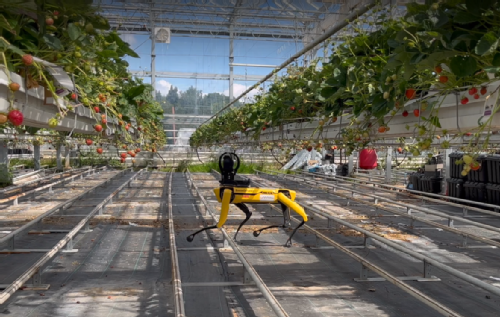
Harry Boyce, Project Engineer at WMG at the University of Warwick added: “Our research with Crombot aims to address growers’ scepticism of new technology and, most importantly, cost. It will unlock the potential for adoption of robotics solutions in horticulture, and facilitate a UK offering to a huge global market.
Alex Keller, Principal Engineer at WMG at the University of Warwick, said: “Boston Dynamic’s Spot robot could be an ideal solution for an agricultural monitoring robot, but it is currently very expensive and further research is needed to understand if Spot could progress to challenges such as harvesting and more.
“This is why we are continuing to develop our in-house robotic capabilities, so that we can help industry to create robotic solutions that are affordable and realistic for the grower, which still deliver high impact and high return on investment.
“We hope to hear from growers who would like to be involved in this research – finding out how they can incorporate robots in their practices too.”
Find out more about WMG here https://warwick.ac.uk/fac/sci/wmg/ or contact wmgbusiness@warick.ac.uk.
Notes to Editors
University of Warwick press office contact:
Annie Slinn
Communications Officer | Press & Media Relations | University of Warwick
Email: annie.slinn@warwick.ac.uk
WMG secures funding for two new knowledge transfer partnerships with SME manufacturers pushing the boundaries on process and management innovation
The SME Group at WMG, University of Warwick, has embarked on two major projects with Bellagio Stone and Radius Systems thanks to over £200k in funding from Innovate UK’s Knowledge Transfer Partnership (KTP) scheme.
funding from Innovate UK’s Knowledge Transfer Partnership (KTP) scheme.
A KTP is a three-way collaboration between a company, an academic institution (in this case WMG at the University of Warwick) and a graduate or postgraduate. KTPs are designed to help businesses improve their competitiveness and productivity through shared knowledge, technology, and skills.
Bellagio Stone’s two-year project will create a new cultural management and leadership framework within the business following a recent merger, enabling it to push productivity and prepare for future expansion. Bellagio will transform its operations in the stonemasonry industry, capitalising on a range of long-term growth ambitions.
Radius Systems manufacturers of innovative plastic pipeline solutions will work on a two-year project with WMG to analyse, design and implement a process control system to reduce process variation in the continuous manufacture of water, gas and hydrogen infrastructure pipes.
Simon Broome, Innovation Manager at WMG who works with SMEs to secure KTP funding said: “We are delighted to announce these major new KTP projects. Both Bellagio Stone and Radius Systems have showed a fantastic appetite to grow their businesses and engage with the University to achieve their goals. We are excited about the potential ahead and are now in the process of recruiting the KTP Associates who will deliver the projects in the businesses.”
Mike Boyden, Operations Director at Bellagio Stone Ltd said: “We are really excited to have been awarded the funding to begin the KTP project in conjunction with WMG. We have worked on a number of really successful projects with WMG in the past and feel the KTP has great potential to help develop our business further. Having recently completed a business merger, this targeted approach of supporting specific hurdles we are facing, will help unite both businesses and really drive improvements in productivity, purchasing power and overall efficiencies. We are really grateful to all the team involved with supporting the application and look forward to getting started.”
Allen Clarke Technical Director at Radius Systems Ltd said: “We are delighted to be awarded the funding through Innovate UK and the opportunity to further work with WMG. We have many ideas and initiative to further enhance our manufacturing processes and drive or business to the next level. The scheme will give us great insight into our chosen technical subjects whilst enhancing our World class manufacturing and Industry 4.0 philosophy. Thank you to all involved with this venture and looking forward to getting started in Autumn 2023.”
Find out more about WMG’s SME programmes here: WMG SME Group | How can we help you? (warwick.ac.uk)
WMG celebrates first cohort of Digital and Technology Solutions Degree Apprenticeship graduates
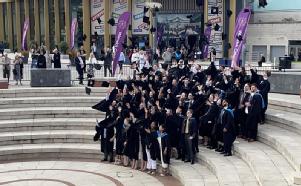 Congratulations to the first apprentices to complete a Digital and Technology Solutions Degree Apprenticeship at WMG, University of Warwick, who graduated at the end of July. Of the 68 graduates, an impressive 44% achieved a first class degree.
Congratulations to the first apprentices to complete a Digital and Technology Solutions Degree Apprenticeship at WMG, University of Warwick, who graduated at the end of July. Of the 68 graduates, an impressive 44% achieved a first class degree.
Established in 2019, the BSc Digital and Technology Solutions (DTS) Degree Apprenticeship has been developed in collaboration with employers in the engineering sector. The programme brings together academia and industry to empower early talent to become confident technology solutions professionals.
As technology advances and the digital skills gap in the UK widens, employers are seeking new ways to innovate and adapt. Apprentices on the DTS Degree Apprenticeship spend four years studying and working, developing the high-quality skills that companies need for business growth. Apprentices graduate with the ability to deliver technology solutions to develop new products and services, and increase productivity using digital technologies.
WMG is passionate about supporting organisations with their workforce strategies, whether that be upskilling employees or recruiting new talent. The Degree Apprenticeship team has built strong employer partnerships to provide programmes that equip employees with the specialised skills that businesses need now, and for the future.
Edward Stone, Senior Careers Cohort Lead at JLR, commented on the impact of DTS apprentices on the business: “At JLR we have been involved from the inception of the DTS Degree Apprenticeship programme, working closely with WMG in its development and application for our business. The knowledge and skills being developed by our apprentices play a key part in closing a critical skills gap fundamental to the ongoing success of JLR as we undertake the transformation of our business to meet the ever-changing challenges of the automotive industry.”
Reflecting on this important milestone for our graduates and for the DTS Degree Apprenticeship programme, Professor Gill Cooke, Pro-Dean (Education) at WMG said: “I am delighted that DTS has had its first graduating cohort; WMG colleagues have completed some incredible work to enable our students to graduate on the course across various discipline streams. Well done to our first graduates!”
Associate Professor and Course Lead for the DTS Degree Apprenticeship programme, Dr Alaa Al Sebae, added: “I was filled with joy when witnessing the first cohort of graduates walking across the stage with smiles and pride. Their dedication and hard work over the past four years studying while working have set an exceptional standard for future learners. We are truly proud of their accomplishments and have no doubt that they will continue to shine brightly in their current and future careers.
“We hope to maintain close connections, and that they visit frequently as guest speakers to inspire future cohorts. Congratulations once again to our graduates, and may you move forward to make a positive impact in the world!”
Associate Professor and DTS Degree Apprenticeship Founding Course Leader and Course Designer, Dr Freeha AzmatLink opens in a new window, said: “It was a huge pleasure to welcome the first DTS cohort to WMG four years ago, and I am so excited to see all of them progressing to the next stage of their careers now.
“The continuous effort and hard work of apprentices, close collaboration between employers and the University team from course inception to the delivery phase has made this programme successful. Congratulations to all.”
For more information about WMG Degree Apprenticeships, please contact the team or visit the website.
International experts developed the foundational ISO standard for the safety of self-driving vehicles
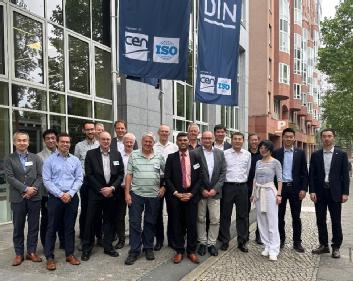 A new international standard has been published which lays the foundations for safe deployment of self-driving vehicles by creating a common approach to define the operating conditions of self-driving vehicles, which is also known as the Operational Design Domain (ODD) (i.e., operating conditions).
A new international standard has been published which lays the foundations for safe deployment of self-driving vehicles by creating a common approach to define the operating conditions of self-driving vehicles, which is also known as the Operational Design Domain (ODD) (i.e., operating conditions).
Led by Professor Siddartha Khastgir from WMG, University of Warwick, UK, and supported by an international group of experts, the very first international standard for safe operation of self-driving vehicles, Road Vehicles — Test scenarios for automated driving systems — Specification for operational design domain – ISO 34503 has been published. This standard will be relevant to every self-driving vehicle developed and manufactured anywhere in the world. The new standard is based on BSI PAS 1883, developed by BSI the UK National Standards Body.
In simplistic terms, ODD is a definition of where your self-driving vehicle is going to operate. This standard provides specifications for defining these operating conditions in a common manner.
The standard classifies ODD into three key categories:
· Scenery elements: non-movable elements (e.g., roads, bridges, traffic lights),
· Environment conditions: weather and other atmospheric conditions; and
· Dynamic elements: all movable objects and actors.
The importance of the concept of ODD is highlighted in the latest European Union’s Act on Automated Driving System (adopted in Aug 2022) which puts the concept of ODD as a cornerstone of the safety assurance process of an automated vehicle. Similar approaches are being considered at the upcoming regulations at United Nations Economic Commission for Europe.
This international standard is a big step to facilitate the commercialisation of self-driving vehicles in a wider global society while also safeguarding the safety of this emerging technology. International organisations and local governments or regulatory agencies can use this standard as a guide to develop their regulations and policies on self-driving vehicles. Autonomous vehicle developers and manufacturers around the world can now design and test their technology based on internationally aligned safety benchmarks, create accurate marketing and communication materials, and build societal trust in the technology.
WMG in collaboration with BSI committee AUE/15 Safety related to vehicles, worked with global partners in countries such as United States, Germany, Japan, China, France, Austria, Canada, Israel, Sweden, Finland, South Korea, Australia, to develop and finalise the ISO standard for the safety of automated vehicles.
Professor Siddartha Khastgir, Head of Verification & Validation, Intelligent Vehicles said:
“Defining the Operational Design Domain is the first step in designing a safe self-driving vehicle. Furthermore, due to the diversity in stakeholders in this ecosystem (e.g., developers, regulators, local authorities etc.), it is essential we have a common way to define such a fundamental concept of safety.
“Successful standardisation efforts are only possible with true international collaboration. I am grateful to experts from various countries worldwide who have engaged and contributed actively to this standard. I am pleased to see more efforts kick-starting which building on the concept of ODD and this standard.”
This standardization activity is underpinned by strong research outcomes from the CCAV and Innovate UK funded OmniCAV research project by WMG; and also, by the research conducted as part of Professor Khastgir’s UKRI Future Leaders Fellowship.
Nick Fleming, Associate Director, Transport and Mobility, BSI said:
“It’s exciting to see the launch of this new international standard, given the potential benefits that can be realized by testing automated vehicles so they can operate safely on our roads. Having a common language to describe the Operational Design Domain (ODD) of an automated vehicle, with the ODD effectively describing the environment and conditions that an automated vehicle is capable of operating in, will be valuable to test and deploy these vehicles safely.
“This new ISO standard has been inspired by the UK document, BSI PAS 1883:2020, the first taxonomy for ODDs developed in conjunction with UK experts and the government’s Centre for Connected and Automated Vehicles (CCAV).
“BSI would like to thank Professor Khastgir for his effort in helping to lead this work at the international level which, along with BSI PAS 1883, shows the leadership the UK is having in the development of global standardization for automated or self-driving vehicles.”
Sarah Gates, Director of Public Policy at Wayve, said:
“We’re pleased to see the launch of this new international standard. The concept of ODDs is the basis of deploying self-driving vehicles safely. A common way of describing ODDs across industry is therefore vital for creating the highest safety standards, bolstering public trust and supporting the regulatory frameworks required to commercially deploy self-driving technology on a global scale.
“We look forward to continuing to work closely with WMG to ensure that safety standards for self-driving technology are rigorous, and to increase confidence in the exciting technology we’re developing here at Wayve, which will unlock a safer, smarter and more sustainable transport system.”
ISO 34503 was developed by ISO technical committee ISO/TC 22/SC 33 Vehicle dynamics, chassis components and driving automation systems testing.
It can be purchased from your national standardisation body or through the ISO Store.
This standardisation activity is underpinned by strong research outcomes from the CCAV and Innovate UK-funded OmniCAV research project by WMG; and also, by the research conducted as part of Professor Khastgir’s UKRI Future Leaders Fellowship.
NOTE TO EDITORS: Link to ISO 34503: https://www.iso.org/standard/78952.html
Media contact: Annie Slinn, Communications Officer (Sciences), Annie.Slinn@warwick.ac.uk | Caitlin Evans, WMG Marketing and Communications Executive, Caitlin.Evans@warwick.ac.uk
WMG supports holiday workshops
WMG at the University of Warwick’s Outreach Team was pleased to take part in the Royal Institution’s (Ri) holiday workshops.
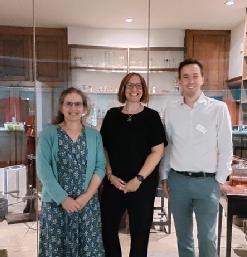 Professor Margaret Low and Dr Phil Jemmett both led sessions at the holiday workshops designed to bring all areas of science - including mathematics, computing and engineering - to life for 9 to 14 year olds.
Professor Margaret Low and Dr Phil Jemmett both led sessions at the holiday workshops designed to bring all areas of science - including mathematics, computing and engineering - to life for 9 to 14 year olds.
Professor Margaret Low’s session was a fun and creative introduction to programming using TurtleStitch. TurtleStitch is free, easy to use, and generates patterns that can be stitched by embroidery machines, enabling the creation of physical things from code.
At Dr Phil Jemmett’s session he asked, ‘Where is engineering?’ Dr Jemmett explained how every product, tool, device and service relies on engineers designing, refining and creating solutions to problems. Students used programmable electronics and sensors, and had the opportunity to make a product for the future.
Dr Phil Jemmett, Widening Participation Co-ordinator at WMG, University of Warwick, said: “The Royal Institution has centuries of tradition in educating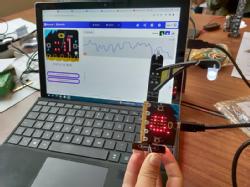 people about science in a fun and engaging way. We are so proud to have supported the holiday workshop programme for another year, and continue to work with one of the most famous scientific bodies in the world. What better place to showcase the engineering and innovation that WMG is part of in building the future? We aimed to show people how simple it can be to start to create their own projects, whether making a smart city for the future, or controlling an embroidery machine in Margaret’s workshop. And it really showed in the engagement of the students in the activities – the things they were able to build in one day were mind-blowing.”
people about science in a fun and engaging way. We are so proud to have supported the holiday workshop programme for another year, and continue to work with one of the most famous scientific bodies in the world. What better place to showcase the engineering and innovation that WMG is part of in building the future? We aimed to show people how simple it can be to start to create their own projects, whether making a smart city for the future, or controlling an embroidery machine in Margaret’s workshop. And it really showed in the engagement of the students in the activities – the things they were able to build in one day were mind-blowing.”
Professor Margaret Low, Director of Outreach and Widening Participation at WMG, University of Warwick, showed her commitment to making science accessible: “Science, engineering, mathematics, and computer science are not traditionally seen as being fun subjects to dip into. With these workshops we were able to provide an inspiring introduction for young people, and perhaps set them on a path to becoming scientists or engineers in the future. Working in partnership between a university and a public body like the Ri is a good example of how we can create opportunities for young people to discover what they want to do, and be empowered to achieve it.”
Peter Gallivan, Family Programme Manager, at the Royal Institution, explains: “Holiday Workshops at the Royal Institution are one of the main ways we work with young people, welcoming around 2,000 young people across the summer to get hands-on exploring STEM subjects. The sessions run by Margaret and Phil are some of my favourites, as they showcase how creativity and imagination are important skills used by scientists and engineers. It was a delight to see their sessions packed full of excited young scientists happily working together to solve a variety of engineering challenges. How else would you want to spend your summer holidays?!”
Find out more about WMG’s Outreach programmes here: https://warwick.ac.uk/fac/sci/wmg/about/outreach/
